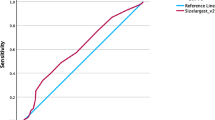Abstract
Purpose
Currently, the most widely used method of treatment of urinary tract stones is extracorporeal shock wave lithotripsy (SWL). Patient and stone characteristics are important for SWL success. We evaluated noncontrast computed tomography (NCCT) characteristics of urinary tract stones for the prediction of SWL success.
Methods
Records of patients who underwent NCCT before SWL treatment between January 2008 and June 2012 were retrospectively evaluated. Demographic data were recruited from patient files. Hounsfield units (HU), stone size and skin-to-stone distance (SSD) were measured on NCCT. After serial measurements of the highest HU value (HUmax) and lowest HU value (HUmin), HU value was calculated as the average of these two values (HUave). These parameters were compared between successful [stone-free (SF) group] and unsuccessful [residual fragment (RF) group] cases after SWL.
Results
A total of 254 patients, 113 kidney stones and 141 ureteral stones, were evaluated. Mean age was 51.0 ± 14.6 (18–87) years, and mean stone size was 10.9 ± 3.7 mm. Stone diameter, HUmax, HUmin and HUave were significantly lower in SF group when compared with RF group for both kidney and ureteral stones (p < 0.05). We also found that SSD for kidney stones was predictive for SWL success.
Conclusions
We suggest that HUmax, HUmin and HUave values are significant predictors of SWL success for both kidney and ureteral stones. They might be used in daily clinical practice for patient counselling.
Similar content being viewed by others
References
Chaussy C, Brendel W, Schniedt E (1980) Extracorporeally induced destruction of kidney stones by shock waves. Lancet 2:1265–1268
Weld KJ, Montiglio C, Morris MS, Bush AC, Cespedes RD (2007) Shock wave lithotripsy success for renal stones based on patient and stone computed tomography characteristics. Urology 70(6):1043–1046
Fielding JR, Steele G, Fox LA, Heller H, Loughlin KR (1997) Spiral computerized tomography in the evaluation of acute flank pain: a replacement for excretory urography. J Urol 157:2071–2073
Mostafavi MR, Ernst RD, Saltzman B (1998) Accurate determination of chemical composition of urinary calculi by spiral computerized tomography. J Urol 159:673–675
Joseph P, Mandal AK, Singh SK, Mandal P, Sankhwar SN, Sharma SK (2002) Computerized tomography attenuation value of renal calculus: can it predict successful fragmentation of the calculus by extracorporeal shock wave lithotripsy? A preliminary study. J Urol 167:1968–1971
Gupta NP, Ansari MS, Kesarvani P, Kapoor A, Mukhopadhyay S (2005) Role of computed tomography with no contrast medium enhancement in predicting the outcome of extracorporeal shock wave lithotripsy for urinary calculi. BJU Int 95:1285–1288
Wang LJ, Wong YC, Chuang CK, Chu SH, Chen CS, See LC, Chiang YJ (2005) Predictions of outcomes of renal stones after extracorporeal shock wave lithotripsy from stone characteristics determined by unenhanced helical computed tomography: a multivariate analysis. Eur Radiol 15:2238–2243
Yoshida S, Hayashi T, Ikeda J, Yoshinaga A, Ohno R, Ishii N, Okada T, Osada H, Honda N, Yamada T (2006) Role of volume and attenuation value histogram of urinary stone on noncontrast helical computed tomography as predictor of fragility by extracorporeal shock wave lithotripsy. Urology 68:33–37
Nakada SY, Hoff DG, Attai S, Heisey D, Blankenbaker D, Pozniak M (2000) Determination of stone composition by non-contrast spiral computed tomography in the clinical setting. Urology 55:816–819
Pareek G, Hedican SP, Lee FT Jr, Nakada SY (2005) Shock wave lithotripsy success determined by skin-to-stone distance on computed tomography. Urology 66:941–944
Denstedt JD, Clayman RV, Preminger GM (1990) Efficiency quotient as a means of comparing lithotriptors. J Endourol 4(suppl):100
Dretler SP, Polykoff G (1996) Calcium oxalate stone morphology: fine tuning our therapeutic distinctions. J Urol 155:828–833
Wang YH, Grenabo L, Hedelin H, Pettersson S, Wikholm G, Zachrisson BF (1993) Analysis of stone fragility in vitro and in vivo with piezoelectric shock waves using the EDAP LT-01. J Urol 149:699–702
Bon D, Dore B, Irani J, Marroncle M, Aubert J (1996) Radiographic prognostic criteria for extracorporeal shock-wave lithotripsy: a study of 485 patients. Urology 48:556–561
Chaussy C, Fuchs G (1986) Extracorporeal lithotripsy in the treatment of renal lithiasis. 5 years’ experience. J Urol (Paris) 92(6):339–343
Mattelaer P, Schroder T, Fischer N, Jakse G (1994) In situ extracorporeal shock wave lithotripsy of distal ureteral stones: parameters for therapeutic success. Urol Int 53:87
Dretler SP (1988) Stone fragility—a new therapeutic distinction. J Urol 139:1124–1127
Ouzaid I, Al-qahtani S, Dominique S, Hupertan V, Fernandez P, Hermieu JF, Delmas V, Ravery V (2012) A 970 hounsfield units (HU) threshold of kidney stone density on non-contrast computed tomography (NCCT) improves patients’ selection for extracorporeal shockwave lithotripsy (ESWL): evidence from a prospective study. BJU Int 110:438–442
Conflict of interest
The authors declare that they have no conflict of interest.
Author information
Authors and Affiliations
Corresponding author
Rights and permissions
About this article
Cite this article
Celik, S., Bozkurt, O., Kaya, F.G. et al. Evaluation of computed tomography findings for success prediction after extracorporeal shock wave lithotripsy for urinary tract stone disease. Int Urol Nephrol 47, 69–73 (2015). https://doi.org/10.1007/s11255-014-0857-0
Received:
Accepted:
Published:
Issue Date:
DOI: https://doi.org/10.1007/s11255-014-0857-0




